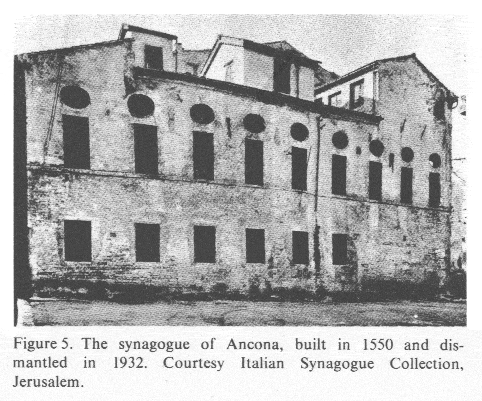
An exceptional and unprecedented event, which included the intervention of Doña Gracia Mendes-Nasí, occurred in the city of Ancona, an important commercial port on the East coast of Italy. This city was declared a “papal state” in 1429. The Popes (Clement III, Paul III and others) wanted to develop Ancona as a center of international trade. And to achieve this goal, the popes gave the Jews of the city permission to open banks and to offer credit. Due to this pro-Jewish attitude, many anusim (= Jews converted by force to Christianity) from Portugal and Spain began to settle in Ancona, which thanks to its privileged geographical location, became an ideal base for maritime trade with the Ottoman Empire.
On February 21, 1547 the pope invited “anyone … from the kingdoms of Portugal … including New Christians [= anusim. YB] to settle in Ancona. ”
In 1550, the Jewish population of Ancona had about 2,700 people. In that year, one of the largest synagogues in Italy was built there (see picture).
But everything changed in 1555 when a new pope, Gian Pietro Carafa (Paul IV), took over at the Vatican. This pope, known for his undisguised anti-Semitic inclination, turned against the Jewish population of Ancona. The Jews were humiliated, deprived of their trade privileges and locked in a ghetto. The new Pope also reestablished the inquisition in Ancona and began to persecute theanusim. About 100 anusim-Jews were imprisoned by the Inquisition and threatened with being executed at the stake or sold as slaves if they did not renounce their Jewish faith. Some, as they did in the past, chose a forced fake conversion to save their lives. Those who did not accept the conversion were sold in the slave market of Malta. And 24 anusim, who had begun to live openly as Jews, refused to convert (even fictitiously) and were condemned to be burned in the infamous autos-de-fe of the Inquisition.
The news of the execution of these anusim came to the ears of Doña Gracia Mendes in Constantinople. On March 9, 1556, at the request of Dona Gracia, Sultan Suleiman the Magnificent wrote to the pope and demanded the release of the imprisoned men, whom he called his subjects. The Sultan also requested the release of their confiscated property.
As this did not work, Doña Gracia summoned all Jewish leaders and planned a response that was unprecedented in the history of the Jewish people: an economic boycott against the city of Ancona.
Very respectful of the rabbinic authorities, Doña Gracia also sought Halakhic support for her plan and instructed Rabbi Yehuda Faraj to explain the situation to the chief rabbis of Constantinople: Rabbi Yosef ibn Lev, Rabbi Abraham Yerushalmi, Rabbi Solomon Bilia and Rabbi Abraham Saba, and asked for their support to establish the boycott and persuade their congregation members to follow it.
Doña Gracia used her influence and power to declare a boycott of the port of Ancona. No ship of her company or of the companies that negotiated with her company, would embark or disembark in Ancona. The port to use would be from now on the port of Peso, or the already famous port of Venezia.
It should be remembered that Doña Gracia Mendes was the head of the wealthiest family in the Ottoman Empire and one of the most influential families in Europe. And their expertise was maritime trade.
The port of Ancona remained closed and abandoned for a considerable time, and the boycott had a great effect on the commerce of Ancona. As seen in a document of the Council of the city of Ancona addressed to the Pope and in which the Council tells the Pope to remove the Inquisition from Ancona because it was antagonizing the eastern merchants and adversely affecting the commerce of the city.
Although this was not the first economic boycott of early modern times, it was the first organized by Jews.
Never before, until the days of Doña Gracia Mendes, the Yehudim had the power to defend ourselves, react or punish the abuses of the Church and the Inquisition. Dona Gracia Mendes, once again, demonstrated her courage, leadership and passion to defend her Jewish brothers, wherever they were.
The story of the 24 Yehudim who were executed AL QIDDUSH HASHEM for their refusal to convert to Christianity, was recorded in the papal archives and it could be found in Rabbenu Gedalia Ibn Yahia’s book “Shalshelet HaQabala” (pp. 276-278) 1526-1588). See the book HERE
These are their names
Simeon Ben Menachem
Yoseph Guascon
Samuel Guascon.
Abraham Falcon
Isac Nahmias
Salomon Alguadish
Moses Paggi
Salomon Pinto
Yoseph Moljo
Abraham Cerilia
David Nahas
Abraham di Spagna
Moses Barzilon
David Reubén
Salomon Iahia
David Sadicairo
Yoseph Verdai
Yoseph Pappo
Yacob Cohen
Yacob Montalban
Abraham Lobo
Yacob Mozzo
Abraham Cohen
And a woman, whose name is unknown.
זצוק”ל
The execution of these Yehudim in 1555 shook the Jewish communities of Europe and inspired elegies (qinot) that to this day are recited in some communities of Italy during Tish’a beA
Fuente: halakhaoftheday.org
 eSefarad Noticias del Mundo Sefaradi
eSefarad Noticias del Mundo Sefaradi
